

Go Seigen (Wu) bio by his brother. There was a Chinese father who once said many years ago, “I will pass my calligraphic skills to my oldest son; my writing skills to my second oldest son; my go skills to my youngest son.”

His youngest son was Go Seigen. In this translation, I have used “Wu Qing Yuan” (his name in Chinese pinyin) instead of “Go Seigen” since I feel that’s how his brother would like it to be translated. In particular, Mr Wu Yan, his brother and the author, constantly referred him as “Qing Yuan”, a brotherly calling that cannot be replaced by “Seigen”, I feel. Please get used to one of the greatest names in go history in his mother language: Wu Qing Yuan! I also made some notes for some explanations that I felt necessary.
Cho Chikun at Sensei. Cho Chikun (Japanese: 趙 治勲 Chō Chikun, Korean: 조치훈, 趙 治勲, RR: Jo Chi-hun, MC-R: Cho Ch'i-hun, born June 20, 1956) is a professional go player.
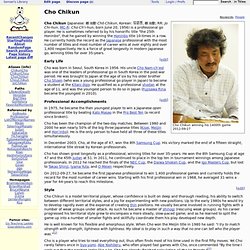
He is sometimes referred to by his honorific title "the 25th Honinbo", that he gained by winning the Honinbo title 10-times in a row. He currently holds the record as the Japanese professional with the most number of titles and most number of career wins at over eighty and over 1,400 respectively. He is a force of great longevity in modern Japanese go, winning titles for over 35-years. Early Life. Iyama Yuta at Sensei. Cho U at Sensei. Cho U (張 栩 Chō U, in Chinese: Zhang Xu, Pinyin: Zhāng Xǔ, in Korean: 장쉬 (Jang Shwi), born 20 January 1980), Nihon Ki-in 9 dan pro from Taiwan.

Cho U was a pupil of Rin Kaiho, is the husband of Kobayashi Izumi and the son-in-law of Kobayashi Koichi. He came to Japan at the age of 10, a behavior reminiscent of Rin Kaiho, Cho Chikun, Cho Shoen, and Cho Nam-ch'eol. Each of these professionals came to Japan at a young age to study go. With his win in the 47th Judan, Cho became the first professional to simultaneously hold five of the seven major titles (considering the major titles since 1977). He has now held all of the Japanese Big Titles at least once. Akiyama Jiro at Sensei. Kitani Minoru at Sensei. Kitani Minoru (木谷実, 25 January 1909 - December 1975) was a professional Japanese Go player.

Kitani had reached the rank of 9-dan. Kitani was a student of Suzuki Tamejiro. Teacher of famous Japanese professionals including: Ishida Yoshio, Kato Masao, Takemiya Masaki and many others (see Kitani Dojo). In 1934, Kitani won 10 straight best of three matches against other top players in a win and continue tournament run by Yomiuri. His opponents were all top players, including Go Seigen, and the matches were ended when the supply of opponents was exhausted. In 2010 nominated to the Nihon KiIn Hall Of Fame. Go Seigen at Sensei. Go Seigen (吳清源, Wu Qingyuan, Wu Quan, Go Izumi, b. 12 June 1914 in Fuzhou, Fujian Prov., China), is a professional 9-dan.
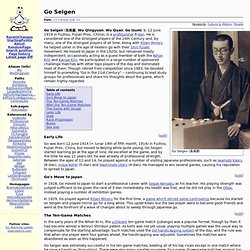
He is considered one of the strongest players of the 20th Century and, by many, one of the strongest players of all time. Along with Kitani Minoru he helped usher in the age of modern go with their Shin Fuseki movement. He moved to Japan in the 1920s, but remained mostly independent, occasionally acting as a guest member of both the Nihon Kiin and Kansai Kiin. He participated in a large number of sponsored challenge matches with other tops players of the day and dominated most of them.
Though retired from competition since 1983, he devoted himself to promoting "Go in the 21st Century" -- continuing to lead study groups for professionals and share his thoughts about the game, which remain highly-regarded. Early Life. Go Seigen: The Go Master. June 12 is Go Seigen’s birthday.
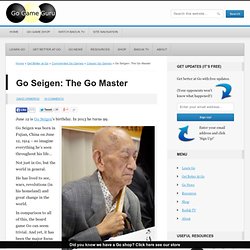
In 2013 he turns 99. Go Seigen was born in Fujian, China on June 12, 1914 – so imagine everything he’s seen throughout his life… Not just in Go, but the world in general. He has lived to see, wars, revolutions (in his homeland) and great change in the world. In comparison to all of this, the board game Go can seem trivial. [This article has been updated. Go Seigen. Un article de Wikipédia, l'encyclopédie libre.
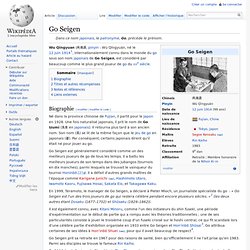
Go Seigen. Kitani Minoru. Un article de Wikipédia, l'encyclopédie libre.
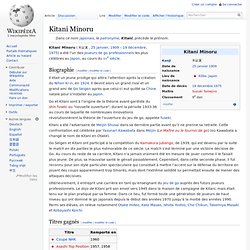
Kitani Minoru ( 木谷実 , 25 janvier, 1909 – 19 décembre, 1975) a été l’un des joueurs de go professionnels les plus célèbres au Japon, au cours du XXe siècle. Biographie[modifier | modifier le code] Il était un jeune prodige qui attira l’attention après la création du Nihon Ki-in, en 1924. Il devint alors un grand rival et un grand ami de Go Seigen après que celui-ci eut quitté sa Chine natale pour s'installer au Japon. Go et Kitani sont à l’origine de la théorie avant-gardiste du shin fuseki ou "nouvelle ouverture", durant la période 1933-36 au cours de laquelle de nombreuses innovations révolutionnèrent la théorie de l’ouverture du jeu de go, appelée fuseki.
Kitani a été l’adversaire de Meijin Shusai dans sa dernière partie avant qu’il ne prenne sa retraite. Takemiya Masaki. Lee Chang-ho. Un article de Wikipédia, l'encyclopédie libre.

Lee Chang-ho (en hangeul coréen : 이창호 et en hanja coréen : 李昌鎬), né en 1975, est un joueur de go professionnel coréen. 9ème dan, il est considéré comme l'un des meilleurs joueurs mondiaux actuels. Il a été un élève de Cho Hunhyun. Style de jeu[modifier | modifier le code] Lee Chang-ho est un joueur au style très calme et réputé imperturbable ; quel que soit le cours de la partie, son expression en face du goban reste impassible si bien qu'on le surnomma "Statuette du Bouddha".
Il analyse avec minutie un grand nombre de variations et choisit souvent la solution qui comporte le moins de risque sauf lorsque vraiment il se retrouve dans une impasse, mais c'est ce qui fait toute sa force. Quand il commença à gagner contre bon nombre de professionnels très forts, on se demanda comment il arrivait à gagner avec un jeu aussi "basique" et beaucoup de joueurs commencèrent à critiquer son style. Titres[modifier | modifier le code] Hon'inbō Shūsai. Hon'inbō Shūsai.
Fujisawa Hosai. Un article de Wikipédia, l'encyclopédie libre.
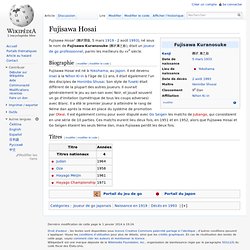
Fujisawa Hosai' (藤沢朋斎, 5 mars 1919 - 2 août 1993), né sous le nom de Fujisawa Kuranosuke (藤沢庫之助), était un joueur de go professionnel, parmi les meilleurs du XXe siècle. Biographie[modifier | modifier le code] Fujisawa Hosai est né à Yokohama, au Japon. Il est devenu insei à la Nihon Ki-in à l'âge de 11 ans. Il était également l'un des disciples de Honinbo Shusai. Eio Sakata. Biography[edit] Sakata's challenger for the 1965 Meijin was Rin Kaiho, who at the time was just 23 years old.
Sakata was the overwhelming favorite, but Rin won the title. Sakata challenged two years in a row but could not win the Meijin back. Rin then went on to take the Hon'inbō from Sakata. Minoru Kitani. Biography[edit] He earned the nickname "the Prodigy" after winning a knockout tournament. He defeated eight opponents from the Kiseisha in a row during 1928. He played a celebrated match with then retiring Honinbō Shūsai. The Nobel Prize winning author Kawabata Yasunari used this game in his novel "The Master of Go". Go Seigen. Biography[edit]
Go Seigen.